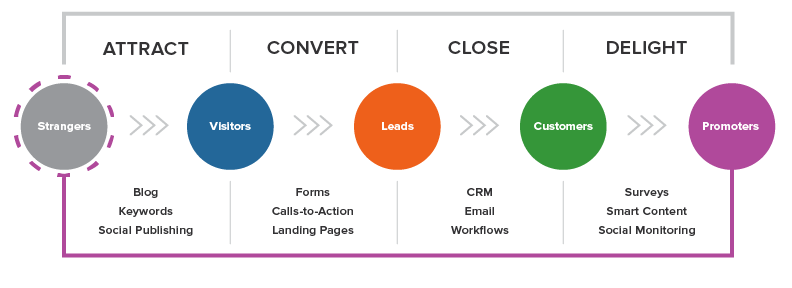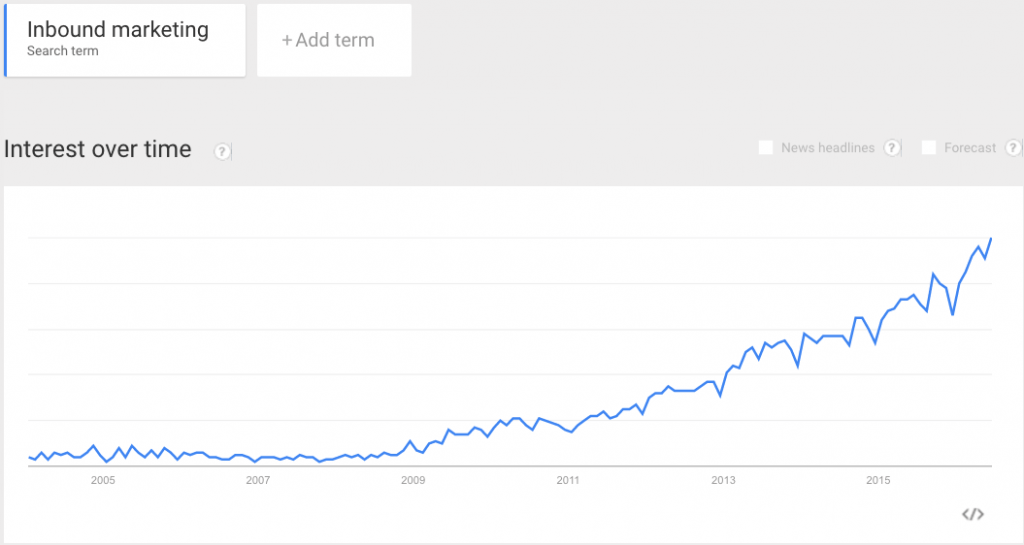When our friends Brian Halligan and Dharmesh Shah introduced the concept of inbound marketing way back in 2006, they fundamentally shifted the way brands were forced to think about marketing. As the everyday consumer began relying more heavily on digital research and positive reviews or referrals prior to any formal interaction with a company (see Google’s Zero Moment of Truth), it became clear that brands needed to rethink their strategy for attracting potential future customers with content they actually wanted to consume. The result: inbound marketing, a marketing philosophy that that prioritized improving the quality of owned media channels (websites, blogs, email, social, etc.) over making substantial investments in paid media channels (radio, TV, direct mail, PPC, display, etc.). For a great introductory resource to the inbound methodology, HubSpot has you covered.
via HubSpot
Fast-forward 10 years, and it’s clear the popularity of inbound marketing has skyrocketed.
View the full report in Google Trends
Inbound Marketing and the Internet Treasure Hunt
The problem is that because of this widespread adoption, we are now at a point where it is very (repeat: VERY) difficult for your content to get noticed when you’re only publishing on channels you control, even when it is ten times better than anything else in your category. The amount of content clouding our ability to make sense of the world is staggering. The internet has effectively become a treasure hunt for consumers and brands alike – consumers have to sort through a heap of junk to find useful information, and brands have to search for the places their consumers live and do whatever it takes to be helpful to them in those locations. Most often, these locations exist outside of a brand’s website (at least at first), which leads the most savy brands to look at external channels to reach their audiences – some paid, some earned.
So what does this mean?
It means that inbound marketing cannot be a standalone strategy for the vast majority of brands today.
As one of the first HubSpot Platinum agencies, we know, this may sound like heresy to many of our peers, partners, and followers, but it certainly doesn’t to our clients, most of whom use HubSpot. Which is why I’d like to share a little more about why we believe inbound and outbound marketing are better together than they are apart.
1) Inbound on its own takes too long.
One is that it just takes too long. If you’re just doing owned media or just doing inbound marketing, it takes a long time in the competitive landscape that is the internet today to get your brand to rise up and to get enough traffic and enough contacts to be able to use it as a standalone strategy to really see short term results and success inside your business.
But often we’ll compliment it with a paid campaign where we take a piece of content and we push through paid channels to try to see who will read it, who is responding to it, and are they people who meet our lead criteria or our sales qualified lead criteria. Which leads me to my second point.
2) Paid media can help you make good decisions.
Paid media can help you test things a lot faster than just inbound by itself can. We are all trying to test hypotheses in the marketplace every single day. What subject line do we think will work? What whitepaper title do we think will work? What landing page design do we think will work? And the shorter time we can get a lot of throughput or a lot of different context using those assets helps us make better and better decisions as marketers. So again, we believe in inbound marketing strategy – a fantastic strategy – but it really needs to be complemented so we can see faster what’s going to work and what’s not.
3) Outbound as a compliment to inbound.
The last one is that targeted outreach or just pure outbound efforts, like direct mail – let’s use as an example – can help you control your own destiny a little bit better as a brand. So I’ll use Element Three as an example: we use inbound marketing – absolutely – to try to get more subscribers, more blog readers, more people in our database that know about our brand and are excited about what we’re doing, and are learning from the content that we’re putting out. But we also, on the sidelines, have a targeted list of companies and brands that we would just love to do business with. And so, we have directed outbound strategies to really reach out to those companies in a proactive way. So we might send them, let’s say, a 3-D box that’s FedEx packaged that they open and we want them to take some type of response. So, after they see that, they may then go to our website and engage with our inbound marketing and our content. But at that point, it’s really a complement to a direct outreach strategy. We see that as a way to really control our own destiny as a brand and the types of companies and the brands we work for and represent. We want to be selective in places. And so while inbound is part of that ecosystem of the sales process, it does not stand alone for us in that aspect.
So, 100% inbound marketing ought to be part of your brand strategy. In this day, we’ve got to make sure we’re dumping our brains out into the internet through the forms of blog posts, whitepapers, and lots of online content, but we don’t believe that the best brands ever use that as a standalone strategy. That it has to be complemented with other things to really reach the level of success that’s necessary to compete today.







